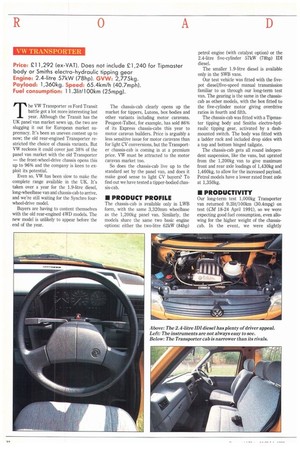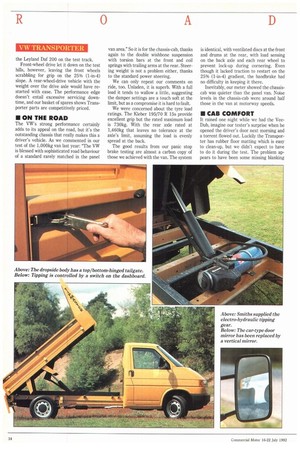VW TRANSPORTER
Page 34

Page 35

Page 36

Page 37

If you've noticed an error in this article please click here to report it so we can fix it.
Price: 211,292 (ex-VAT). Does not include £1,240 for Tipmaster body or Smiths electro-hydraulic tipping gear Engine: 2.4-litre 57kW (78hp). GVW: 2,775kg.
Payload: 1,360kg. Speed: 65.4km/h (40.7mph).
Fuel consumption: 11.314/100km (25mpg).
The VW Transporter vs Ford Transit battle got a lot more interesting last year. Although the Transit has the UK panel van market sewn Up, the two are slugging it out for European market supremacy. It's been an uneven contest up to now; the old rear-engined Transporter restricted the choice of chassis variants. But VW reckons it could cover just 38% of the panel van market with the old Transporter — the front-wheel-drive chassis opens this up to 96% and the company is keen to exploit its potential.
Even so, VW has been slow to make the complete range available in the UK. It's taken over a year for the 1.9-litre diesel, long-wheelbase van and chassis-cab to arrive, and we're still waiting for the Synchro fourwheel-drive model.
Buyers are having to content themselves with the old rear-engined 4WD models. The new model is unlikely to appear before the end of the year. The chassis-cab clearly opens up the market for tippers, Lutons, box bodies and other variants including motor caravans. Peugeot-Talbot, for example, has sold 86% of its Express chassis-cabs this year to motor caravan builders. Price is arguably a less sensitive issue for motor caravans than for light CV conversions, but the Transporter chassis-cab is coming in at a premium price. VW must be attracted to the motor caravan market too.
So does the chassis-cab live up to the standard set by the panel van, and does it make good sense to light CV buyers? To find out we have tested a tipper-bodied chassis-cab,
• PRODUCT PROFILE
The chassis-cab is available only in LWB form, with the same 3,320mm wheelbase as the 1,200kg panel van. Similarly, the models share the same two basic engine options: either the two-litre 62kW (84hp) petrol engine (with catalyst option) or the 2.4-litre five-cylinder 57kW (78hp) ID! diesel.
The smaller 1.9-litre diesel is available only in the SWB vans.
Our test vehicle was fitted with the fivepot diesel/five-speed manual transmission familiar to us through our long-term test van. The gearing is the same in the chassiscab as other models, with the box fitted to the five-cylinder motor giving overdrive ratios in fourth and fifth.
The chassis-cab was fitted with a Tipmaster tipping body and Smiths electro-hydraulic tipping gear, activated by a dashmounted switch. The body was fitted with a ladder rack and included drop sides with a top and bottom hinged tailgate.
The chassis-cab gets all round independent suspension, like the vans, but uprated from the 1,200kg van to give maximum front and rear axle loadings of 1,430kg and 1,460kg, to allow for the increased payload. Petrol models have a lower rated front axle at 1,350kg.
• PRODUCTIVITY
Our long-term test 1,000kg Transporter van returned 9.31it/100km (30.4mpg) on test (CM 18-24 April 1991), so we were expecting good fuel consumption, even allowing for the higher weight of the chassiscab. In the event, we were slightly
disappointed with the laden figure of 11.3lit/100kg (25.0mpg) recorded around our Kent test route.
This compares with the 10.8lit/100km (26.2mpg) from the Nissan Cabstar and 9.4lit/100krn (30.0mpg) from the Leyland Daf 200 Dropside. Unladen, the Transporter returned a more respectable 9.91it/100km (28.4mpg). Allowing for the weight differences between the vehicles in our comparison chart, the Transporter is not disgraced by this performance.
The diesel chassis-cab has the heaviest GVW of the Transporter range at 2,775kg. The Tipmaster body and tipping gear weigh in at 355kg, giving a 1,005kg payload with a 75kg driver. It's difficult to make direct comparisons with our listed rivals as none
is fitted with tipping bodies. Body volume is perhaps more relevant for a panel van, but with the 3.13mm-deep sides fitted, it tops out 1.41m.
If the Transporter gives away a little in fuel consumption, it makes up for it in outright performance from the smooth, torquey five-pot diesel. It could show a clean pair of rear wheels to both the Nissan and the Leyland Daf 200 on the test track.
Front-wheel drive let it down on the test hills, however, leaving the front wheels scrabbling for grip on the 25% (1-in-4) slope. A rear-wheel-drive vehicle with the weight over the drive axle would have restarted with ease. The performance edge doesn't entail excessive servicing downtime, and our basket of spares shows Transporter parts are competitively priced.
• ON THE ROAD
The VW's strong performance certainly adds to its appeal on the road, but it's the outstanding chassis that really makes this a driver's vehicle. As we commented in our test of the 1,000kg van last year: "The VW is blessed with sophisticated road behaviour of a standard rarely matched in the panel van area." So it is for the chassis-cab, thanks again to the double wishbone suspension with torsion bars at the front and coil springs with trailing arms at the rear. Steering weight is not a problem either, thanks to the standard power steering.
We can only repeat our comments on ride, too. Unladen, it is superb. With a full load it tends to wallow a little, suggesting the damper settings are a touch soft at the limit, but as a compromise it is hard to fault.
We were concerned about the tyre load ratings. The Kleber 195/70 R 15s provide excellent grip but the rated maximum load is 730kg. With the rear axle rated at 1,460kg that leaves no tolerance at the axle's limit, assuming the load is evenly spread at the back.
The good results from our panic stop brake testing are almost a carbon copy of those we achieved with the van. The system
is identical, with ventilated discs at the front and drums at the rear, with load sensing on the back axle and each rear wheel to prevent lock-up during cornering. Even though it lacked traction to restart on the 25% (1-in-4) gradient, the handbrake had no difficulty in keeping it there.
Inevitably, our meter showed the chassiscab was quieter than the panel van. Noise levels in the chassis-cab were around half those in the van at motorway speeds.
• CAB COMFORT
It rained one night while we had the VeeDub, imagine our tester's surprise when he opened the driver's door next morning and a torrent flowed out. Luckily the Transporter has rubber floor matting which is easy to clean-up, but we didn't expect to have to do it during the test. The problem appears to have been some missing blanking plugs beneath the windscreen. We haven't heard of this before and have not experienced it with our long-term test van so we hope it was an isolated incident.
Chassis-cabs can suffer from restricted rearward seat movement for the driver but the Transporter has plenty of space, even for over-six-footers. The cab is narrower than vans such as the Ford Transit, Renault Trafic and the Fiat/PSA Sevel triplets. Consequently, the dual passenger seat is a bit cosy and lacks the generous proportions we've come to expect from German seating.
The trim is predominantly grey but the seats and dash are in different shades. Plentiful expanses of glass help to ensure it's not too oppressive, while providing good all-round visibility. Thankfully, the car-like driver's door mirror has been junked on the chassis-cab in favour of a vertical mirror. On both sides the mirrors are mounted on folding frames to give a good view along the wider tipper body. The VW also came equiped with electric windows; amusing to fiddle with in traffic jams but we don't imagine many buyers will plump for the £230 (ex-VAT) option.
The controls and instruments were as in our long-term van, which was fitted with the
optional rev counter, while the tipper had a clock in its place. We prefer the rev counter, usefully marked with a green economy sector. The deeply recessed instruments can be a bit difficult to read in the shade but they are large and well marked.
Ventilation suffers in the same way as in the van; the centre dashboard vents fitted to the Caravelle models are blanked off, leaving the heater-fed outlets at each side. Fresh air might be at a premium but there's plenty of stowage space including a locking glovebox and a large driver's door pocket which includes space for a drinks can.
• SUMMARY
Chassis-cabs might be a departure for VW but most of its European rivals have been churning them out for some time. The Cabstar is the only Japanese rival and Tipmaster offers a tipper conversion. The company simply fits a tipping sub-frame to the body with scissor tipping gear, adding £1,240 (ex-VAT) to the standard Cabstar price.
Renault is the only manufacturer to offer a 4x4 chassis-cab, in the shape of the Trafic with its 2/4WD system, at £11,925 (ex-VAT) in diesel form. The standard Trafic chassis-cab is offered in rear-wheel drive to overcome the traction problems we experienced with the Transporter, and at £9,645 (ex-VAT) is beaten on price only by the Nissan.
Both the Peugeot-Talbot Express and Fiat Ducato are available as SWB and LWB chassis-cabs, the diesel equivalent to the Transporter costing £10,300 (ex-VAT). This leaves the Ford Transit which, like the Transporter, is available as a crew-cab. It's also closest to the Transporter in price, with the 120 SWB diesel 2.72-tonne GVW Standard chassis-cab at £11,490 (ex-VAT), or the Popular at £10,885 (ex-VAT).
At £11,292 (ex-VAT) the Transporter is premium priced. Is it worth it? Build quality is undoubtedly superior to the Renault, Fiat and Peugeot-Talbot, which might be reflected in re-sale values. The Cabstar is one on its own with a strong following in the building trade and the Tipmaster conversion makes it very appealing.
In terms of ride and handling, the VW clearly stands out from its rivals. Include its reasonable fuel consumption and good performance and the extra cost starts to make good sense.
Even so, we can't help feeling that it's chief appeal will be to motor caravan converters, where price is not so sensitive.
• by John Kendall
















































































